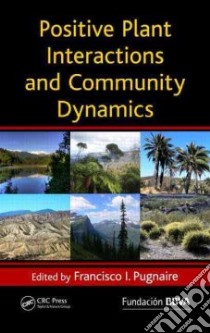Positive Plant Interactions and Community Dynamics - 9781439824948
Un libro in lingua di Pugnaire Francisco I. (EDT) edito da Taylor & Francis, 2010
- € 77.00
- Il prezzo è variabile in funzione del cambio della valuta d’origine
Ever since the concept of the "struggle for life" became the heart of Darwin’s theory of evolution, biologists have studied the relevance of interactions for the natural history and evolution of organisms. Although positive interactions among plants have traditionally received little attention, there is now a growing body of evidence showing the effects of positive interactions between higher plant species. Written by international experts, Positive Plant Interactions and Community Dynamics reviews these developments with particular emphasis on positive interactions and spatial and temporal gradients.
The text addresses key issues in plant ecology and anthropogenic impacts through reviews, syntheses, and the proposition of new concepts. The book begins with coverage of the different approaches used over time and the tools currently available for analyzing the direction, intensity, and importance of plant interactions, and to quantify them accurately. It explains, at least in part, the success of invasive plant species. The book also shows the existence of evolutionary relationships among plants, a decidedly non-individualistic process, which plays an important role in the organization of communities. The book’s focus then shifts to the scale at which facilitation works, assessing its effects from the individual plant to the landscape level, and the impacts of climate change on plant-plant interactions using case studies to illustrate underlying fundamental points relevant to all plant communities. After analyzing the role of positive and negative interactions and their relationship with biodiversity and ecosystem functioning, the text reviews the role of mychorrizal symbiosis in plant-plant interactions, focusing on the effect of mychorhizal-mediated facilitation on the structure and dynamics of plant communities.
A good understanding of natural processes is necessary to manage natural habitats properly, prevent environmental risks, and secure continued ecosystem services. Clearly and concisely written, this book challenges the paradigm that interactions should be considered independently, with little regard to context. Addressing the complex processes at the foundation of ecosystem diversity, the book promotes more rigorous experimental design and opportunities for further research developments in this field.
Informazioni bibliografiche
- Titolo del Libro in lingua: Positive Plant Interactions and Community Dynamics
- Lingua: English
- Autore: Pugnaire Francisco I. (EDT)
- Editore: Taylor & Francis
- Collana: Taylor & Francis (Hardcover)
- Data di Pubblicazione: 09 Gennaio '10
- Genere: NATURE
- Argomenti : Plant communities Plant ecology
- Pagine: 156
- ISBN-10: 1439824940
- EAN-13: 9781439824948


